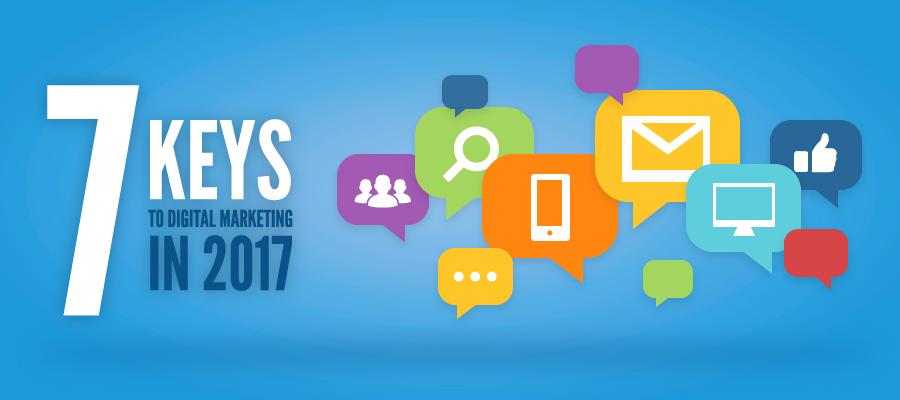
7 Keys to Digital Marketing in 2017
It’s time to look ahead for your business’s marketing efforts. After years of rapid growth, 2016 was the year digital marketing spending finally passed TV and more traditional marketing approaches. The benefits are well-known; not only is it where more and more audiences are consuming content and spending time, but it’s an entirely trackable, metrics-driven way to ensure that ad spend is efficient and performing correctly.
In fact, thinking about how users will engage with your content across the variety of platforms will be key to successful brand marketing in 2017. Planning your digital strategy, and how your online and offline systems work together will help you be more efficient and generate results in your marketing efforts.
With the start of the new year, it’s time to look at the 7 hottest trends shaping digital marketing right now, and how you can leverage these to make your business successful online.
1. Focus on Niche Audiences
Marketing is more personal than it’s ever been. The rise of Facebook’s business ad platform has shown us as marketers that when we create focused audiences around an interest or commonality, we can generate big results for our brands.
The move towards personalization and niche markets isn’t an accident. Social media and search are becoming more crowded as new advertisers move into those spaces. Generic messaging and ads aren’t going to carry the same level of effectiveness anymore. Instead, addressing precise needs and adding value to a narrow audience is often the best way to get attention and drive results.
2. More Shareable Content
Content marketing is over a decade old, but that doesn’t mean that it’s lacking in innovation. With the rise of Clickbait (misleading or implied shocking headlines) a few years ago, marketers realized that traffic was easy to generate through attention-grabbing teasing headlines. Social media is built to share content and to reward those who create content that people want to see.
While Clickbait has since become less of a factor since Facebook started punishing publishers using “clickbait-style” headlines, the general principle still holds true: creating dense headlines of valuable content that people will want to share will bring more clicks and traffic.
3. Live Video
2016 saw the rapid rise of several live-video streaming platforms, including YouTube, Periscope, and the niche-focused Twitch.tv. Facebook Live has been the dominant live-video format, leveraging the targeted capabilities and business page functionalities of the core Facebook platform. Live video has proven to be a whole new way for content creators to build an audience.
Live video shows range from simple informal Q&As to presentations and sales pitches. It’s a whole new way to get in front of and stay connected with your customers on their device of choice.
4. Lead Magnets
Alongside content marketing has been the rise of the Lead Magnet, where brands and businesses offer a promotional bonus to a prospective customer in exchange for an action. This is most typically joining a mailing list or to access bonus content, and due to the value provided by the lead magnet, can be a very effective technique to capture prospect information.
The added value of lead magnets is that a cold audience rapidly becomes a warm audience as they have asked for information, and the material helps that audience start to solve a problem, while providing expertise at the same time. Once a prospect has opted in to receive content, they are warmed through automated messaging and value-adds, creating higher levels of engagement and interest before a business asks for that prospect to take action or purchase.
5. Continued Shift to Mobile
For several years, mobile website traffic has outpaced desktop traffic, and the trend looks set to continue. Always go into your website strategy with a plan for mobile-friendly layout and content, making your site and site content easy to click through and consume. Fast loading is a must, too; nothing is more frustrating for a mobile user than a page that won’t load on their data service.
There is an old journalism technique known as the “inverted pyramid.” Make sure your content does this! Put the biggest, most important idea at the top, followed by supporting details. Let the less important information pull less focus – it’s only meant for a small subset of your audience anyway. The inverted pyramid mindset will help your content flow correctly for visitors who are there finding what’s most important to them, and will take the time to dig in if they see something that has promise to fulfill this need.
6. Conversion Optimization
Overlapping with usability techniques, conversion optimization is about testing different forms of marketing content against each other to see which increases clickthroughs and ultimately lead generation or sales. If you’ve ever taken part in an A/B test, this is one of the core techniques for successful conversion optimization.
There’s no single answer to what makes a website, ad, or landing page convert, however there are best practices and visual cues that give some methods a psychological advantage over others. Testing is important to ensure ongoing movement toward higher conversion rates.
7. Measuring Everything
Part of what makes digital marketing so valuable is the ease with which one can measure return on investment (ROI). With conversion tracking, it’s easier than ever to see trends in the performance of a page or ad and make adjustments as needed. It’s also possible to understand more about your audience and even your traffic; you can quickly see what interests your website audience shares and where they were before visiting your site.
Measurement is critical for ad spend in particular. It’s vital to a digital marketer’s ability to understand what their cost per click and cost per conversion is, and track that all the way to a close rate. Now more than ever before, it’s possible to follow a prospect from early consumption of your content to closed business, understanding more about the time and cost it takes your business to acquire new customers.
2017 in Digital Marketing
More than ever before, digital experience is a necessary part of a business’s marketing mix. With the rapid growth of digital marketing spending, expect it to become a more competitive environment where standing out means narrowly targeting the audience you best appeal to, and providing a good deal of upfront value to start the relationship. Take advantage of new opportunities, such as experiences optimized for mobile devices and live video, to stand out from others in your industry. And don’t forget – we improve what we measure, so make sure that you find ways to track traffic and performance of your marketing efforts. Consider these opportunities when planning your 2017 marketing strategy and stay ahead of the curve.

Tell us what you think
Share your thoughts here in the comments! Have a burning question or feedback about the topic? Let’s keep the conversation going.